Feedforward motor information enhances somatosensory responses and sharpens angular tuning of rat S1 barrel cortex neurons
- PMID: 28059699
- PMCID: PMC5271607
- DOI: 10.7554/eLife.21843
Feedforward motor information enhances somatosensory responses and sharpens angular tuning of rat S1 barrel cortex neurons
Abstract
The primary vibrissae motor cortex (vM1) is responsible for generating whisking movements. In parallel, vM1 also sends information directly to the sensory barrel cortex (vS1). In this study, we investigated the effects of vM1 activation on processing of vibrissae sensory information in vS1 of the rat. To dissociate the vibrissae sensory-motor loop, we optogenetically activated vM1 and independently passively stimulated principal vibrissae. Optogenetic activation of vM1 supra-linearly amplified the response of vS1 neurons to passive vibrissa stimulation in all cortical layers measured. Maximal amplification occurred when onset of vM1 optogenetic activation preceded vibrissa stimulation by 20 ms. In addition to amplification, vM1 activation also sharpened angular tuning of vS1 neurons in all cortical layers measured. Our findings indicated that in addition to output motor signals, vM1 also sends preparatory signals to vS1 that serve to amplify and sharpen the response of neurons in the barrel cortex to incoming sensory input signals.
Keywords: Barrel cortex; Whiskers; neuroscience; primary motor cortex; rat; sensory-motor loop.
Conflict of interest statement
The authors declare that no competing interests exist.
Figures
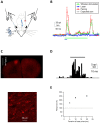
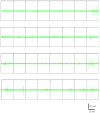
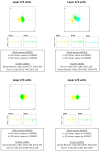

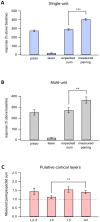


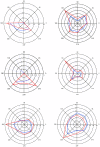
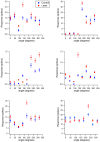

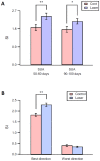
Similar articles
-
Transformation of Perception from Sensory to Motor Cortex.Curr Biol. 2017 Jun 5;27(11):1585-1596.e6. doi: 10.1016/j.cub.2017.05.011. Epub 2017 May 25. Curr Biol. 2017. PMID: 28552362 Free PMC article.
-
Multiple cortical systems influence a single vibrissa muscle.Proc Natl Acad Sci U S A. 2025 Jun 10;122(23):e2503325122. doi: 10.1073/pnas.2503325122. Epub 2025 Jun 3. Proc Natl Acad Sci U S A. 2025. PMID: 40460131 Free PMC article.
-
Activity in motor-sensory projections reveals distributed coding in somatosensation.Nature. 2012 Sep 13;489(7415):299-303. doi: 10.1038/nature11321. Nature. 2012. PMID: 22922646 Free PMC article.
-
Anatomical loops and their electrical dynamics in relation to whisking by rat.Somatosens Mot Res. 1999;16(2):69-88. doi: 10.1080/08990229970528. Somatosens Mot Res. 1999. PMID: 10449057 Review.
-
Dynamics of neuronal processing in rat somatosensory cortex.Trends Neurosci. 1999 Nov;22(11):513-20. doi: 10.1016/s0166-2236(99)01452-6. Trends Neurosci. 1999. PMID: 10529819 Review.
Cited by
-
Touch-evoked traveling waves establish a translaminar spacetime code.Sci Adv. 2025 Jan 31;11(5):eadr4038. doi: 10.1126/sciadv.adr4038. Epub 2025 Jan 31. Sci Adv. 2025. PMID: 39889002 Free PMC article.
-
Activation of Corticothalamic Layer 6 Cells Decreases Angular Tuning in Mouse Barrel Cortex.Front Neural Circuits. 2019 Nov 1;13:67. doi: 10.3389/fncir.2019.00067. eCollection 2019. Front Neural Circuits. 2019. PMID: 31736714 Free PMC article.
-
Behavioral states modulate sensory processing in early development.Curr Sleep Med Rep. 2019 Sep;5(3):112-117. doi: 10.1007/s40675-019-00144-z. Epub 2019 Jul 3. Curr Sleep Med Rep. 2019. PMID: 31662954 Free PMC article.
-
Alternation of Neuronal Feature Selectivity Induced by Paired Optogenetic-Mechanical Stimulation in the Barrel Cortex.Front Neural Circuits. 2021 Sep 1;15:708459. doi: 10.3389/fncir.2021.708459. eCollection 2021. Front Neural Circuits. 2021. PMID: 34566582 Free PMC article.
-
The somatosensory cortex receives information about motor output.Sci Adv. 2019 Jul 10;5(7):eaaw5388. doi: 10.1126/sciadv.aaw5388. eCollection 2019 Jul. Sci Adv. 2019. PMID: 31309153 Free PMC article.
References
-
- Bosman LWJ, Houweling AR, Owens CB, Tanke N, Shevchouk OT, Rahmati N, Teunissen WHT, Ju C, Gong W, Koekkoek SKE, De Zeeuw CI. Anatomical pathways involved in generating and sensing rhythmic whisker movements. Frontiers in Integrative Neuroscience. 2011;5:53. doi: 10.3389/fnint.2011.00053. - DOI - PMC - PubMed
Publication types
MeSH terms
LinkOut - more resources
Full Text Sources
Other Literature Sources

